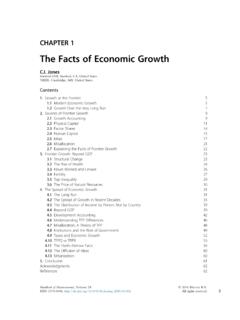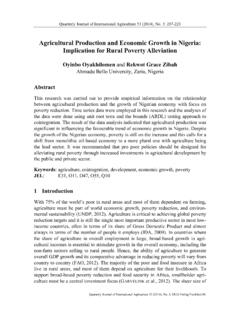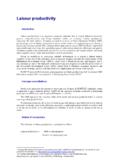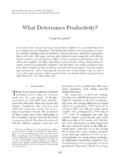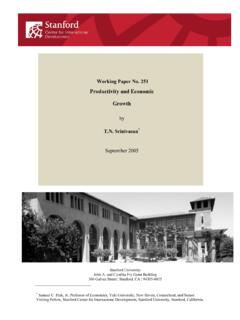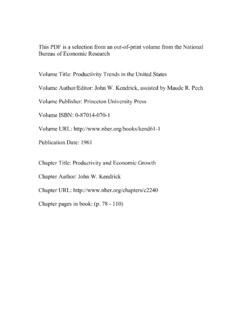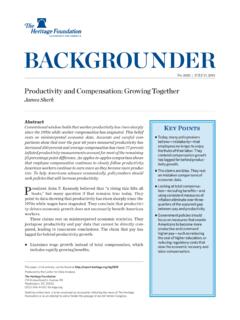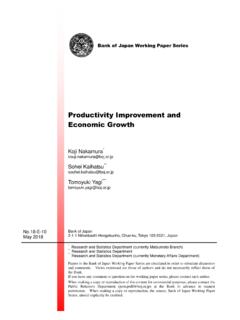Transcription of INNOVATIONAND PRODUCTIVITY GROWTH - Harvard …
1 INNOVATION Schultz LectureDALEW. JORGENSON The puzzle confronting economists has been that the rate of GROWTH of output thatwas being observed has been much larger than the rate of increase in the principalresources that were being measured. It is now clear that this puzzle is of our ownmaking because we have been using measures of capital and labor which had beenrefined and narrowed in ways that excluded many of the improvements that havebeen made in the quality of these resources. Theodore W. Schultz (1962).Thecomputerequipmentmanufacturing industry comprised only percent of added from 1960 2007, but percent of economic GROWTH and 25 per-cent of PRODUCTIVITY GROWTH .
2 By comparisonagriculture accounted for percent of added, but only percent of economicgrowth during this period. This reflects the factthat agriculture has grown more slowly thanthe economy, while the computer industryhas grown thirteen times as fast. However,agriculture accounted for fifteen percent PRODUCTIVITY GROWTH , indicating a verysignificant role for agricultural purpose of this paper is to assess therole of innovation in economic GROWTH dur-ing the period 1960 2007. PRODUCTIVITY growthis the key economic indicator of the importance of innovation in indus-tries like computers and agriculture, this inno-vation accounts for less than twelve percentof GROWTH .
3 The great bulk of economicgrowth in the is due to the replication ofexisting technologies through investment andexpansion of the labor force. Although inno-vation contributes only a modest portion ofeconomic GROWTH , this contribution is vital togains in the standard of predominant role of replication ofexisting technologies in economic growthis crucial to the formulation of economicpolicy. As the economy recovers fromthe Great Recession of 2007 2009, economicpolicy must focus on maintaining the growthof employment and reviving that concentrate on enhancing therate of innovation will have a relatively modestimpact over the intermediate term of 5 10years.
4 However, the long-run GROWTH rateof the economy depends critically on theperformance of a relatively small number ofsectors, such as agriculture and computers,where innovation takes paper begins with a brief historyof PRODUCTIVITY measurement. The traditionalapproach of Simon Kuznets (1971) andRobert Solow (1970), has been supersededby the new framework presented in PaulSchreyer s OECD (2001) manual,MeasuringProductivity. The focus of PRODUCTIVITY mea-surement has shifted from the economy as awhole to individual industries like agricultureand computers. The OECD PRODUCTIVITY man-ual has established international standards foreconomy-wide and industry-level OECD standards for PRODUCTIVITY mea-surement are based on the production accountsconstructed by Jorgenson, Frank Gollop, andBarbara Fraumeni (1987).
5 These accountshave been updated and revised to incorporateinvestments in information technology hard-ware and software by Jorgenson, Mun Ho,and Kevin Stiroh (2005). The EU (EuropeanUnion) KLEMS (capital, labor, energy, mate-rials, and services) study, described by MaryO Mahony and Marcel Timmer (2009), wascompleted on June 30, 2008. This landmarkstudy presents PRODUCTIVITY measurements for25 of the 27 EU members, as well as Australia,Canada, Japan, and Korea, and data for the on those of Jorgenson, Ho, and Stiroh(2005). Current data for the participating coun-tries are available at the EU KLEMS website: hallmark of the new framework forproductivity measurement is the conceptof capital services, including the servicesAmer.
6 J. Agr. (2): 276 296; doi: The Author (2011). Published by Oxford University Press on behalf of the Agricultural and Applied EconomicsAssociation. All rights reserved. For permissions, please e-mail: and PRODUCTIVITY Growth277provided by IT equipment and information technology is based onsemiconductor technology used in comput-ers and telecommunications equipment. Theeconomics of information technology beginswith the staggering rates of decline in theprices of IT equipment used for storage ofinformation and computing. The killer appli-cation of the new framework for productivitymeasurement is the impact of IT investmentsummarized below.
7 The final section sums upthe New Framework for ProductivityMeasurementA detailed survey of recent research on sourcesof economic GROWTH is given in my 2005 paper, Accounting for GROWTH in the InformationAge . A survey of earlier research is given inmy 1990 article, PRODUCTIVITY and EconomicGrowth , presented at the Jubilee of the Con-ference on Research in Income and Wealth,commemorating the fiftieth anniversary of thefounding of the Conference by Kuznets. Addi-tional surveys are provided by Zvi Griliches (2000) posthumous book,R& D, Education,and PRODUCTIVITY , and Charles Hulten s (2001)article, Total Factor PRODUCTIVITY : A ShortBiography.
8 The most serious challenge to the tradi-tional approach to PRODUCTIVITY measurementof Kuznets (1971) and Solow (1970) wasmounted by my 1967 paper with Griliches, The Explanation of PRODUCTIVITY Change .Griliches and I departed radically from themeasurement conventions of the traditionalapproach. We replaced NNP with GNP as ameasure of output and introduced constantquality indexes for both capital and laborinputs. Jorgenson (2002) refers to this as theproduction theoryapproach to key idea underlying ourconstant qual-ity index of labor inputwas to distinguishamong different types of labor inputs.
9 Wecombined hours worked for each type into aconstant quality index of labor input, usinglabor compensation per hour as weights in theindex number methodology Griliches (1960)had developed for agriculture. This consid-erably broadened the concept of substitutionemployed by Solow (1957).While Solow modeled substitution betweencapital and labor inputs, Griliches and Iextended the concept of substitution to includedifferent types of labor inputs as well. Thisaltered, irrevocably, the allocation of economicgrowth between substitution and technicalchange. Constant quality indexes of labor inputare discussed detail by Jorgenson, Gollop, andFraumeni (1987, Chapters 3 and 8, pp.)
10 69 108and 261 300), and Jorgenson, Ho, and Stiroh(2005, Chapter 6, pp. 201 290).Griliches and I introduced aconstant qualityindex of capital inputby distinguishing amongdifferent types of capital inputs. To combinethese capital inputs into a constant qualityindex, we identified prices of the inputs withrental prices, rather than the asset prices usedin measuring capital stock used by Solow andKuznets. This also broadened the concept ofsubstitution and further altered the allocationof economic GROWTH between substitution andtechnical and I employed a model of capitalas a factor of production I had introduced in my1963 article, Capital Theory and InvestmentBehavior.










